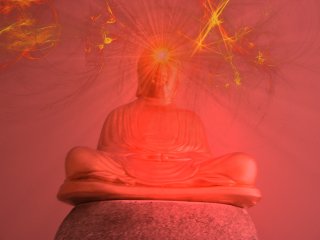Around 30 lakh Dalits are estimated to have converted to Buddhism as part of 50th year celebrations of Ambedkar's deeksha, in what has again underscored a fact that Indian Buddhism has a distinct Dalit hue to it.Since a lâkh [लाख] is one hundred thousand, 30 lâkh makes 3 million. If this estimate is true, that is quite a number of people. However, it is probable that most of the people who showed up were already Buddhists, rather than people who converted to Buddhism as part of the 50th anniversary event.
Reports from organisations involved in deeksha programmes around the country have come up with figures which point to a resurgent conversion activity.
Twenty lakh people are estimated to have congregated at Nagpur, Deekshabhoomi which is at the forefront of Dhammakranti, while another six lakh people attended the second biggest ceremony at Chandrapur on October 15-16.
Maharashtra, owing to Ambedkar's linkages, as also the original Dalit movement, was ahead of all other states in these conversions. Andhra Pradesh, Punjab, MP, UP and Chhattisgarh, too, conducted conversions on a largescale.
According to Y Chinna Rao, who teaches at the Centre for Dalit and Minorities Studies in Jamia Millia Islamia and has compiled a report on the nationwide activities, "The conversion ceremonies were the largest ever to be seen till now after independence. It could give a massive boost to similar activities in future."
The programmes, which started in the run-up to Dussehra through Ambedkar's birth anniversary in October, saw massive activity in Andhra Pradesh.
According to the Hindustan Times, Buddhists might hold the swing vote in the upcoming Assembly elections in the Indian state of Madhya Pradesh:
It is believed that there are 40-45 constituencies where Buddhists are numerically strong enough to make a difference. In fact, there are constituencies in the State where Buddhist vote is as high as 45% as in Khairlanji (Balaghat), currently represented by RPI. The other constituencies with large Buddhist population includes Amla (over 40%), Katangi 30%, Lanji 25%, Barasivni and Kirnapur (30%), Saunsar, Pandurna, Multai, Betul, Parasia, Gohad, Bhander, Mhow, Paraswada and Naryavali (20%). Besides, there are two-dozen more constituencies where the community has more than 10% of the electorate, claims Dr Gajbhiye.Dr. Ambedkar's belief that Dalits can become empowered through conversion to Buddhism seems to be becoming a reality.
Though the data might appear exaggerated to some, experts feel that feeling slighted by the Congress, the community might choose Mayawati and vote for her party en masse. And the statistics are frightening enough for Congress.
[...]
The Buddhist population in the State could be much higher than suggested by the census records as the Dalit converts did not register themselves as Buddhists under the category of religion because of a past law, which stopped the facilities including reservation meant for Scheduled Castes to the neo-Buddhists.
The Buddhist converts were not deemed as Scheduled Castes until the Centre amended the law in 1990 following which the Madhya Pradesh government issued a notification in March 1994 stating that all neo-Buddhists would continue to get the privileges of their caste even after conversion. In fact, it is surmised that the Buddhist population could be well be 40-50 lakh. "Dr Ambedkar was born in Madhya Pradesh and his caste Mahar alone has a population of 38 lakh almost all of whom are Buddhists besides the other castes", said a high official in the government.
南無阿彌陀佛

No comments:
Post a Comment